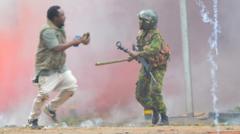The recent reduction of U.S. forces in Syria signifies a notable shift in the Syrian conflict landscape following the fall of Bashar al-Assad.
U.S. Troop Withdrawal from Syria: A New Chapter Unfolds

U.S. Troop Withdrawal from Syria: A New Chapter Unfolds
As the U.S. begins to withdraw troops, Syria faces both hope and renewed threats in a shifting landscape.
The United States military has commenced the withdrawal of hundreds of troops from northeastern Syria, reflecting a significant change in the country's security dynamics since the December fall of President Bashar al-Assad. U.S. officials announced the closure of three out of eight small bases in the region, bringing troop levels down from 2,000 to approximately 1,400. This reduction comes in part due to the assessment of U.S. commanders, who will evaluate the situation further in 60 days to determine if additional cuts are necessary.
The three closed bases include M.S.S. Green Village and M.S.S. Euphrates, as well as a smaller facility. While there has been a marked decrease in threats since Assad's regime fell, the Islamic State remains a formidable presence, particularly in northeast Syria where American forces are largely stationed. However, many other dangers, including Iranian-backed militias and Russian military support for Assad, have been significantly diminished.
Against this backdrop, the Kurdish-led militia that governs much of northeastern Syria recently agreed to merge with the newly formed Syrian government, marking a pivotal moment as Damascus attempts to achieve unity amid ongoing violence. While President Trump has expressed doubts about maintaining any U.S. presence in Syria, the current troop reduction strategy reflects Pentagon and Central Command recommendations aimed at stabilizing the region.
The three closed bases include M.S.S. Green Village and M.S.S. Euphrates, as well as a smaller facility. While there has been a marked decrease in threats since Assad's regime fell, the Islamic State remains a formidable presence, particularly in northeast Syria where American forces are largely stationed. However, many other dangers, including Iranian-backed militias and Russian military support for Assad, have been significantly diminished.
Against this backdrop, the Kurdish-led militia that governs much of northeastern Syria recently agreed to merge with the newly formed Syrian government, marking a pivotal moment as Damascus attempts to achieve unity amid ongoing violence. While President Trump has expressed doubts about maintaining any U.S. presence in Syria, the current troop reduction strategy reflects Pentagon and Central Command recommendations aimed at stabilizing the region.




















